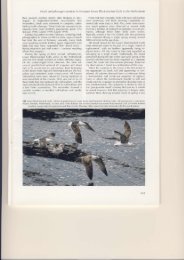Identification of American Herring Gull in a western European context
Identification of American Herring Gull in a western European context
Identification of American Herring Gull in a western European context
Create successful ePaper yourself
Turn your PDF publications into a flip-book with our unique Google optimized e-Paper software.
<strong>Identification</strong> <strong>of</strong> <strong>American</strong> <strong>Herr<strong>in</strong>g</strong> <strong>Gull</strong> <strong>in</strong> a <strong>western</strong> <strong>European</strong> <strong>context</strong>12 1314 1512-15 Presumed <strong>American</strong> <strong>Herr<strong>in</strong>g</strong> <strong>Gull</strong> / Amerikaanse Zilvermeeuw Larus smithsonianus, juvenile, Cobh, Cork, Ireland,8 January 2001 (Jim Wilson). Underparts streaked, not as uniform as underparts <strong>of</strong> two first-w<strong>in</strong>ter smithsonianus present atsame time. Confus<strong>in</strong>gly similar to some ‘dark’ juvenile argentatus-types, but upper- and undertail-coverts densely barred darkand tail almost entirely dark (see plate 9), strongly <strong>in</strong>dicative <strong>of</strong> smithsonianus.Juveniles (plate 1-23)There is wide variation <strong>in</strong> the appearance <strong>of</strong>juvenile smithsonianus, from the most dist<strong>in</strong>ctivetype (c 60%) which is very dark and practicallyuniformly textured on the underparts (plate 1), toless strik<strong>in</strong>g birds which have more mottled, oreven pale-streaked, underparts and which couldeasily escape detection among a flock <strong>of</strong> largegulls <strong>in</strong> Europe (plate 5). In addition to this variationwhich can be seen <strong>in</strong> Atlantic coast populationsat, for <strong>in</strong>stance, Cape May, New Jersey, <strong>in</strong>September, there appears to be another ‘type’ <strong>of</strong>smithsonianus which deserves particular attention.Unfortunately, we have virtually no firsthandexperience with what Howell et al (1999)referred to as ‘Pacific coast [<strong>American</strong>] <strong>Herr<strong>in</strong>g</strong><strong>Gull</strong>s’ which are presumed to orig<strong>in</strong>ate fromhigh-latitude populations and apparently performa long-distance migration to w<strong>in</strong>ter mostly <strong>in</strong>California. Judg<strong>in</strong>g from a few published photographs(eg figures 1, 6 and 10 <strong>in</strong> Howell 2001)and some <strong>of</strong> the <strong>American</strong> <strong>Herr<strong>in</strong>g</strong> <strong>Gull</strong> videoclipsfeatured <strong>in</strong> The large gulls <strong>of</strong> North America(Dunn et al 1997), the birds that w<strong>in</strong>ter <strong>in</strong> westNorth America <strong>in</strong>clude a much higher proportion<strong>of</strong> what might be described as ‘problematic’ firstyearsthan we observed on the east coast.Possibly the closest th<strong>in</strong>g to a ‘high-latitude’-typesmithsonianus we have seen on this side <strong>of</strong> theAtlantic is a bird, still <strong>in</strong> full juvenile plumage, atCobh, Cork, Ireland <strong>in</strong> January 2001 (plate 8, 9and 12-15, Digg<strong>in</strong> 2001). It was one <strong>of</strong> three7










